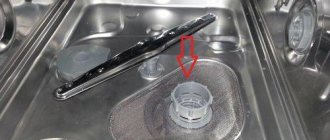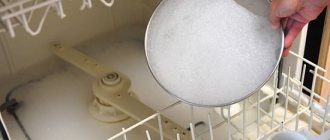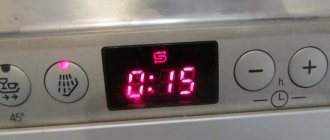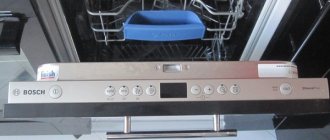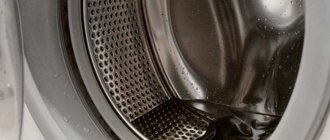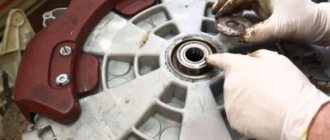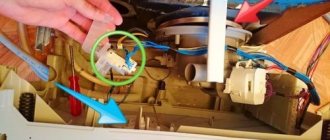Is this a problem or the norm?
In fact, there should always be some liquid in the salt compartment of the dishwasher.
This is necessary to prepare a softening solution, so a certain volume of water in the compartment is the norm.
The instructions for any machine say that when you first start a new device, you need to pour water into this compartment and pour salt on top, which will then displace excess water.
It should go down the drain. In addition, a certain amount of water is also located in other parts of the machine to ensure the safety of its rubber parts from drying out.
Approximately 1-1.5 kg of substance is placed in the compartment of a medium-sized machine at a time. This amount is enough for approximately 1.5-2 months.
Some dishwasher models have an indicator that indicates the water hardness level. When the salt runs out, the indicator will remind you of this. This means that you need to fill up a new batch.
The saline solution should not overflow over the edge of the compartment ; if this happens, you need to remove it from the metal surface of the chamber using a soft cloth and wipe it dry.
The solution cannot be left in place; its concentration is such that it can quickly damage metal parts.
Reference! Thus, the volume of water that needs to be poured into the compartment should not exceed 1-1.5 liters.
When should you ask for help?
If, despite all efforts, water continues to stand in the working chamber, you will have to contact the service department.
If you have not encountered a dishwasher breakdown, call a specialist.
This may already indicate more serious problems, such as:
- Water level sensor malfunction.
- Failure of the drain pump.
- Damage or failure in the electronic control board.
In rare cases, the latter problem can be resolved by flashing the factory firmware. However, the problems described cannot be solved on our own.
Carry out module diagnostics at a service center.
Usually, after going through a full wash cycle, a small amount of water remains at the bottom of the dishwasher - in most cases, this is normal. However, if its level is clearly high, or the washing continues without draining, then this is certainly a malfunction.
An incompetent approach in this matter can further aggravate the situation.
Thus, when there is water in the dishwasher, everyone decides what to do: you can try to do something yourself, or you can immediately contact the service. Often, in case of such malfunctions, this is the very last option.
What can you do if the remaining liquid creates an unpleasant odor in the dishwasher?
The appearance of an unpleasant odor from the compartment can be caused by stagnation of water or its entry back into the machine from the drain hose.
This often happens if short cycles and cold water without drying are used mainly for washing dishes.
The source of the odor is the smallest pieces of food and the layer of deposits that remains on the walls of the compartments and hoses. Over time they rot.
If an unpleasant odor occurs, you need to clean the filters manually, and be sure to turn on the long-term washing mode with high water temperature and drying.
Attention! If the problem is not resolved at one time, you must repeat the cleaning. Usually after hot cleaning the smell disappears completely. For prevention, you need to run a long-term washing mode without dishes at least once every 2 months.
Why does the dishwasher leave water at the bottom: reasons
The reasons for the dishwasher not emptying completely can vary.
So, the described phenomenon is a consequence of:
- the location of the drain hole is too high in relation to the floor and, accordingly, incorrect placement of the drain hose;
- blockage;
- failure of the liquid level sensor (pressostat);
- improper operation of the pump (drain pump), including due to difficult rotation of its impeller;
- failure of the control module.
An excessively high location of the drain hole above the floor level makes it impossible to fully pump out the waste liquid and its accumulation in the PMM chamber.
Blockages form in the filter area, hoses and pipes and prevent the unit from emptying.
A breakdown of the liquid level sensor leads to the fact that the control unit, which does not receive real data, does not send a command to the pump that pumps out water.
Incorrect operation of the pump can result in either a partial drainage of the waste liquid or a complete cessation of its pumping (in the event of a complete failure of the element).
Failure of the control module leads to failure of the machine.
Failures in which the dishwasher leaks into the tray and the leakage protection system turns on
Three classes of malfunctions lead to Aquastop operation:
- internal leaks of the dishwasher (connections of pipes and hoses, washing chamber, etc. leak directly into the tray);
- external leaks, when their scale is large enough (for example, a damaged drain hose or dishwasher door flows onto the floor, and water flows from the floor into the pan);
- failure of the leakage protection system itself or the electronics associated with it.
Each of the faults is discussed in detail in the list of faults below.
The seal of the washing tank cup (sump with filters) has worn out - from 1800 rubles.
Therefore, the bottom of the washing chamber has lost its tightness, and water leaks into the tray during washing.
This malfunction is often found in Bosch and Siemens dishwashers with a service life of more than 5 years.
Signs
The dishwasher leaked from under the glass of the washing tank during washing, and Aquastop worked.
How to fix
The rubber seal on the cup needs to be replaced.
For some brands of dishwashers, repair kits with seals are not sold, so you have to replace the tank cup assembly.
Note! RemBytTech specialists use sealant only as a last resort, since it does not provide long-term reliable sealing, and after some time a repeated leakage will occur.
Leaking connections of pipes, hoses and pumps - from 1900 rubles.
Structurally, modern PMMs have two pumps (drain and recirculation), a three-way valve that switches the water flow during washing and to drain, a settling tank (glass) where filters are located, a tank for salt and resin (ion exchanger), etc. All these units are connected by pipes and hoses. It is the places where they connect that most often leak. However, leaks can also occur in any other places in the flood, circulation or drain paths.
Signs
The dishwasher leaked from under the glass of the washing tank during washing, and Aquastop worked.
How to fix
The technician checks the water fill, circulation or drain paths to detect the location of the leak. Based on the diagnostic results, clamps are tightened and seals or seals are replaced. If the pipes and/or hoses are damaged, they are replaced with new ones.
The drain hose is leaking - from RUB 1,500.
It has become disconnected or damaged. When there is an internal leak, the Aquastop system always works. If the leak is external, then everything depends on its scale. For example, if the hose is disconnected at the connection to the sewer, water after washing will pour out onto the floor and, most likely, will flood the tray with the Aquastop sensor. If the damage to the hose occurs outside the dishwasher, and it is minor, the hose will leak slightly onto the floor when draining, but the pan will not flood.
Signs
When draining, Aquastop may be triggered and/or water may appear on the floor.
How to fix
If the hose is damaged, the technician replaces it with a new one. When disconnected, it is fixed in its original place.
Filters are clogged - from RUB 1,300.
The washing tank overflowed due to poor water circulation due to filters clogged with food debris.
Signs
The leakage protection system was activated during the washing process. The dishwasher may also be leaking at the corners of the door.
How to fix
The dishwasher filters need to be cleaned.
Corrosion and leaks in the washing tank - from 1300 rubles.
In PMMs with a long service life, the washing tank usually rots in the stamping areas near the pan glass.
Signs
There is a leak during the wash cycle, the leakage protection has activated.
How to fix
The tank needs to be replaced.
If the hole is small and the scale of corrosion is small, there is the option of sealing the washing compartment with a high-temperature sealant. With such repairs, the dishwasher can last another 3 months to 2 years.
In general, with such leaks, you should think about buying a new car.
Cracked salt tank or heat exchanger canister - from 2000 rubles.
After use, there is always water left in the PMM: in the salt tank, in the heat exchanger canister and other components. If such a machine is left for a long time in a room with a negative temperature, the water will freeze, and the plastic vessels and hoses that contained water may burst.
Signs
The dishwasher, which was in the cold, leaked while washing or while drawing water. Aquastop worked.
How to fix
The salt tank, heat exchanger canister and other damaged components need to be replaced.
Faulty pressure switch - from 1600 rubles.
The level sensor itself has failed or the pressure sampling chamber or pressure switch tube is dirty. As a result, overflow occurs and leakage protection is activated.
Signs
The Aquastop system turned on while filling the dishwasher with water.
How to fix
The technician rinses the pressure sampling chamber and blows out the level sensor tube.
If the sensor itself malfunctions, a complete replacement of the pressure switch is necessary.
The Aquastop sensor has failed - from 1900 rubles.
Incorrectly reports a leak.
Signs
The dishwasher shows the Aquastop error, although there is no water in the pan.
How to fix
The sensor needs to be replaced.
The control module is faulty - from 2500 rubles.
The Aquastop controls in the module do not work correctly.
Signs
The dishwasher shows the Aquastop error, although there is no water in the pan.
When a leak in the pan is not associated with a malfunction
Turning on Aquastop does not always signal a leakage of equipment, much less a breakdown. Here is a list of reasons why the leakage protection system is triggered, which are easy to fix yourself.
- There is a leak in the utilities surrounding the dishwasher. Often PMM has nothing to do with it, but sewerage, plumbing, and pipe connections are leaking. Water from utility leaks is poured into the pan and activates Aquastop. Or there have been cases when housewives spilled water on the countertop under which the dishwasher stood; the moisture flowed through the joints of the countertop into the tray and triggered the leakage protection system.
- Filters are clogged . If the filters are dirty, the water does not circulate well during washing and overflow may occur in the washing tank. As a result, the Aquastop system is activated. Clogged filters must be cleaned according to the instructions for your dishwasher. Moreover, equipment manufacturers recommend checking the condition of the filters after each dishwashing. If you don't, now is the time to start. Also, before loading the dishwasher, clear the dishes of large food debris, this will prevent the filters from clogging.
- Detergents not intended for dishwasher use . Often, inexperienced PMM users use compositions for manual dishwashing (for example, Fairy). This leads to the formation of a very large amount of foam. It climbs out of the dishwasher along with the water, gets into the tray, and Aquastop works. If you encounter such a situation, turn off the PMM as soon as possible and unplug the cord from the outlet. Then drain the water from the pan and wait a day or two for everything to dry. If after drying the machine does not start washing dishes, most likely the electronics have flooded - the control unit has failed and requires repair or replacement.
- The sink siphon to which the machine drain is connected is clogged . If you use a dishwasher and sink at the same time with a clogged siphon, water from the overfilled siphon will flow into the dishwasher and create an overflow. To fix the problem, drain the water from the PMM pan and clean the sink siphon. To prevent water from the siphon from entering the dishwasher, install a check valve on the dishwasher drain hose or connect the machine directly to the sewer.
Have you tried everything, but the dishwasher still activates Aquastop and reports a leak? It looks like you have a malfunction that requires the intervention of a technician.
Electronic module failure
Remember the point about non-working buttons and the complete lack of reaction of the equipment to your manipulations? If constant intake and drainage is accompanied by such symptoms, the problem is in the board. Most often, the pump triac fails - the pump can work even when there is no water in the system. The board elements can be soldered, but this can only be done by a person with certain tools and skills. In the most difficult cases, the module needs to be changed, but this is such an expensive operation that it is easier to buy a new PMM.
Checking and replacing the pump
If your Bosch dishwasher does not drain water and you cannot hear the sound of the pump running, you will have to check and possibly replace this part. For this:
- Remove water from the PMM chamber in any convenient way.
- Remove the drain filter.
- Place the machine on its side.
- Remove the pan and disconnect the Aquastop system sensor from it.
- Remove the pump and disconnect the pipes from it.
- Check the impeller (it should rotate freely). If it jams, replace the pump.
- Check the resistance at the pump contacts with a multimeter. It should be within 200 Ohms if the pump is working properly. Otherwise, the pump must be replaced.
- Make sure that the pump is receiving voltage from the control unit. If not, the ECU may be faulty.
Removing the pump for diagnostics and replacement
In conclusion, I would like to note that it is better to entrust the diagnosis and replacement of such faulty parts as the pump, pressure switch and computer to qualified technicians. They have the experience and the necessary equipment to check, and you won’t have to look for original spare parts for repairs.
